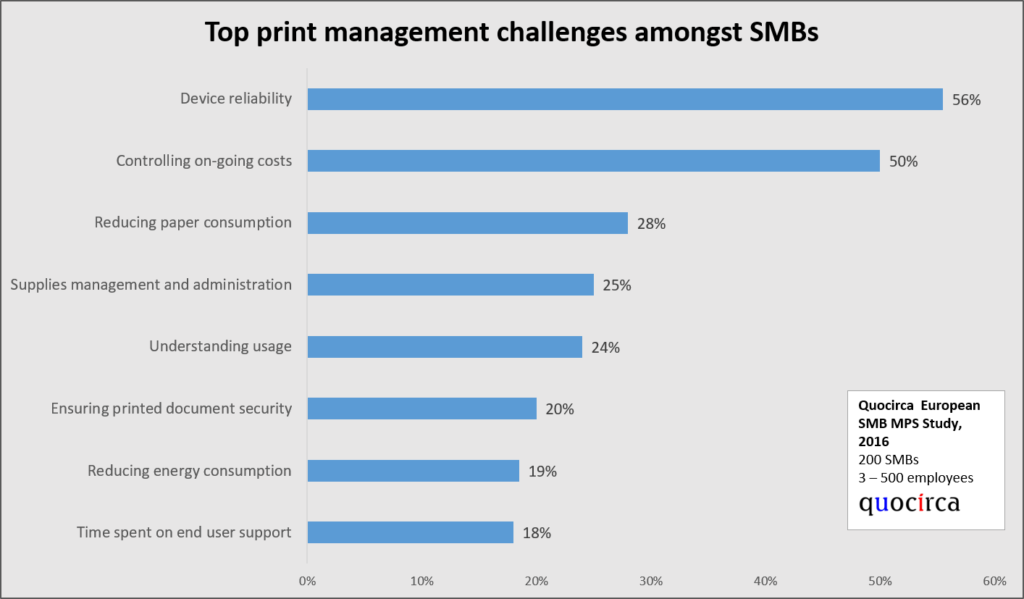Note: This article was filed by a paid contributor to Xerox Corporation.
Small and mid-sized businesses (SMB) continue to explore the potential of managed print services (MPS) to help them overcome the challenges of managing print in-house. With many SMBs reliant on printing to support business activities – over 70% of SMBs indicated in a recent Quocirca study that printing was critical or very important 1 the opportunity for channel partners to take advantage of the MPS opportunity has never been greater. Recognizing the benefits of lower costs, greater agility and better service availability, SMBs are willing to transfer more responsibility for elements of their print infrastructure to trusted MPS partners. By offloading routine maintenance and support to an MPS provider, SMBs can avoid productivity loss and unnecessary downtime.
How MPS can solve print management challenges
Left unmanaged, SMBs’ dependence on print can be a huge cost and productivity drain, as many lack the resources or budget to deal with time consuming print management tasks. Quocirca research1 revealed that, among SMBs with between 3 and 500 employees, device reliability (56%) and cost control (50%) are the top print management challenges. Reducing paper consumption (28%) followed in third place. With over half of SMBs reporting an increase in color print volumes, the need is to address the escalating cost of consumables through print policy and reporting tools is further heightened.

Fortunately, MPS can address these challenges and many SMBs have successfully made the transition to working with an MPS provider. MPS marks a shift from an ad-hoc, transactional approach to a contractual model for printing. MPS contracts are typically monthly or quarterly, encompassing hardware (purchased or leased) along with service and supplies (ink and toner), based on a cost-per-page model. Typically, an audit of the print fleet is conducted to assess opportunities for cost reduction and productivity efficiency.
Many SMBs have already migrated from break/fix-type contracts to more comprehensive proactive services. Beyond device consolidation, advanced MPS offerings include predictive maintenance, continuous monitoring and the deployment of solutions to drive productivity and enhance security. One thing is clear, these capabilities are no longer purely the domain of the large enterprise. SMBs can now gain access to “enterprise-class MPS” through flexible, cloud-based delivery models.
MPS benefits are far reaching
Quocirca’s research reveals that the top reason for a move to MPS is to reduce costs (both hardware and consumables), lower the burden on IT staff and gain a better understanding of print usage. Indeed, the benefits of MPS are far reaching, including:
- Reduced and predictable costs. Lease-based agreements overcome the need for capital expenditure to purchase new hardware and replace a front-loaded capital expense/ operating expense model with a pure operating expense one with monthly payments, which include hardware, service and supplies. This provides SMBs with transparent and far more predictable costs.
- Reduced burden on IT staff. By using an MPS provider, SMBs to free up resources and can focus on running their business. Automated supplies replenishment means staff are no longer burdened with administrative tasks such as ordering consumables and all that it entails.
- Increased reliability and performance. Predictive support and maintenance minimizes device downtime which is vital for SMBs who rely heavily on printing to support business processes.
- Simplified accounting. MPS provides a unified contract approach, rather than having disparate processes for managing different suppliers for service and consumables.
- Better visibility into usage. Consolidated invoicing and management reporting enables a business to understand consumption patterns by devices and users. This provides transparency and the capability for the business to exercise control on future usage where needed.
Leveraging cloud services
These benefits are just the tip of the iceberg. MPS can reach its full potential of driving productivity and business performance when delivered as a cloud service. The synergy with MPS and cloud-based services enables SMBs to access enterprise class mobile, document workflow and security technology that they would not normally be able to afford or justify. Particularly when integrated with smart MFP technology, MPS can provide SMBs with a cost-effective route to accessing the latest capabilities for secure content management, collaboration, storage, retrieval and distribution. Often available as flexible, cost-effective, cloud-based models, which scale as their business grows.
Xerox, for example has a broad range of workflow offerings available on its Xerox® ConnectKey® smart MFP platform. Xerox has made further inroads in its MPS cloud offerings through its partnership with Cisco. Xerox MPS runs on Cisco’s Borderless Network Architecture, offering cloud-based mobile printing and embedded network print security. This is a prime example of how to blend MPS and cloud services into a service package that help SMBs make their print infrastructure more efficient.
Partners can help navigate the market
MPS is an opportunity for IT focused channel partners looking to expand long-term revenue opportunities in the SMB market. However, they would be wise not to address the SMB space as a single market. Indeed, each segment has its own drivers, barriers and priorities. Because the market is awash with diverse offerings, SMBs are looking for trusted partners that can help them navigate the market, and pull together the best MPS to addresses specific needs.
A cloud-based MPS offering is a compelling proposition for SMBs, and means that channel partners can benefit from predictable recurring revenues. As the cloud opens up a range of more diverse services that SMBs may not have been able to access before, MPS focused channel partners can increase their reach into the existing customer base as well as new customers. At the same time, the customer can look to a trusted channel partner to deliver varied services, which brings things all under one contract, billing cycle and support structure.
Ultimately channel organizations that build flexible MPS offerings to suit customer needs on a case-by-case basis will succeed in staying relevant. By concentrating on up-selling to an existing customer base and transitioning to operate in a managed services provider role, the channel can demonstrate the value-add required when it comes to MPS.
1. Quocirca European SMB MPS Study, 2016
Learn more about Xerox Partner Print Services
Learn more about adding managed print services to your portfolio and find out about becoming accredited to sell Xerox Partner Print Services on the Xerox Global Partner Portal.
Become a Xerox Channel Partner
Contact your Xerox account manager, or review the Xerox Global Partner Program and apply to become a Xerox channel partner today, to find out how we will help grow your business.
Join our Xerox Channel Partners LinkedIn community
Looking for more marketing tips and insights from Xerox Agents, Concessionaires, and Document Technology partners from across the globe? Join our private Xerox Channel Partners LinkedIn Group to connect and discuss topics like these with your peers.
Subscribe to the Channel Partner Connection and receive email updates when we publish a new article.[wysija_form id=”1″]




[…] Top 4 Ways MPS and the Cloud Deliver Value for SMBs […]